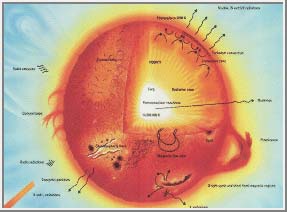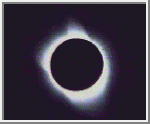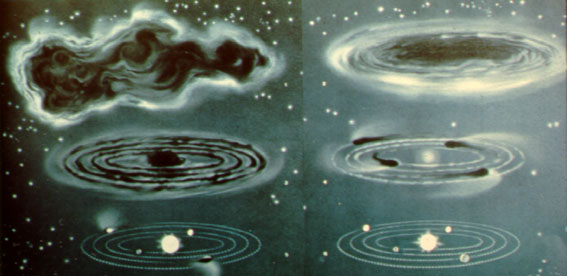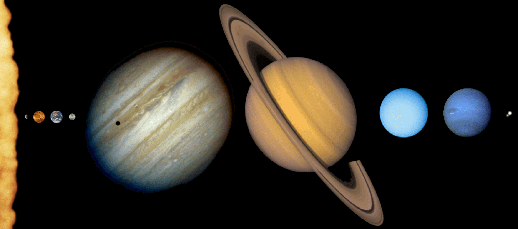What Object in Our Solar System Has the Most Mass and How Do You Know
Chapter 2: The Sun, the Solar System, and the Planets
Our Sun
 | Our sun is just one of uncountable stars (more 100 billion) in a single (deejay shaped) milky way known to u.s.a. equally the Milky Way, so named considering it forms a bright ribbon of arable stars beyond the night sky. We see it every bit such because we ourselves are in it and thus have an on-edge view of it. The lord's day is a comparatively small-scale and immature star. The solar organisation is probably no more than about 4.5 to v billion years old (nosotros will discuss later how we know this), and its average chemical composition is pretty much the aforementioned as that of many other suns and galaxies. Yet, because it is so conspicuous and because its importance was readily realized past long gone primitive societies, it has been the object of veneration by many religions. Picture at left is a depiction of the Egyptian sun god Ra. |
Mass Distribution in the Solar System
The Dominicus contains 99.85% of all the matter in the Solar Arrangement. The planets, which condensed out of the aforementioned disk of textile that formed the Sun, incorporate only 0.135% of the mass of the solar system. Jupiter contains more than twice the matter of all the other planets combined. Satellites of the planets, comets, asteroids, meteoroids, and the interplanetary medium institute the remaining 0.015%. The post-obit table is a list of the mass distribution within our Solar Organization.
| Sun: 99.85% Planets: 0.135% Comets: 0.01% ? Satellites: 0.00005% Minor Planets: 0.0000002% ? Meteoroids: 0.0000001% ? Interplanetary Medium: 0.0000001% ? |  |
Because the sun is however in the business concern of converting hydrogen to helium, information technology is obvious from these figures that just every bit the universe, the composition of the solar organisation is dominated past hydrogen and helium as well. Considering the low affluence of the elements nosotros ourselves are made of (carbon, oxygen, nitrogen, etc.), we are truly made of rare stuff that has been handed downwardly from billions of years before us due to the death of ancestral stars (the ultimate cosmic rebirth?).
The Sun is by far the largest object in the solar system and contains most of the mass. Information technology has a diameter of 1,390,000 km's (as compared to 12,756 km's for the Globe), and its outer visible layer is called the photosphere and has a temperature of vi,000�C (xi,000�F). This layer has a mottled appearance due to the turbulent eruptions of energy at the surface. A link to Soho, a space probe that has been monitoring solar activity since 1995.
Solar energy is created deep within the core of the Sun. It is here that the temperature (xv,000,000� C; 27,000,000� F) and pressure (340 billion times Earth's air pressure level at sea level) is so intense that nuclear reactions take place. The free energy is carried to the surface of the Lord's day through a procedure known every bit convection. This convection causes the sun to churn and bubble on the surface, something that is reflected in observation of sunspots and magnetic field fluctuations. That the surface of the sun behaves substantially equally a (very hot and dense) liquid tin can be seen when major eruptions produce quakes and surface waves. The energy of the sunday is released every bit light and rut. Energy generated in the Sun'due south core takes a million years to reach its surface. Every second 700 million tons of hydrogen are converted into helium ashes. In the process 5 million tons of pure energy is released; therefore, as time goes on the Sun is becoming lighter.
The chromosphere is above the photosphere. Solar energy passes through this region on its style out from the center of the Sun. Solar flares arise in the chromosphere equally bright filaments of hot gas emerging from sunspot regions. The latter are nighttime depressions on the photosphere with a typical temperature of 4,000�C (seven,000�F).
The corona is the outer part of the Sun's atmosphere. It is in this region that prominences appears.
Prominences are immense clouds of glowing gas that erupt from the upper chromosphere. The outer region of the corona stretches far into space and consists of particles traveling slowly away from the Dominicus. The corona can only be seen during total solar eclipses  .
.
The temperature of the corona is about 300 times college than the temperature of the surface of the sun, a mystery for many years. Recent particular observations of so called coronal loops, immense coils of hot, electrified gas, have given scientists new clues as to the underlying causes. New data from NASA's Transition Region and Coronal Explorer (TRACE) spacecraft.
The Dominicus appears to have been active for about four.6 billion years and has plenty fuel to go on for some other v billion years or so. At the end of its life, the Sun will start to fuse helium into heavier elements and begin to swell upwards, ultimately growing so large that it will swallow the Earth. Afterward a billion years as a red giant, information technology will suddenly collapse into a white dwarf -- the final end product of a star like ours. It may accept a trillion years to cool off completely. An alternative view.
Every bit pointed out before, nosotros imagine that vortexes and irregular affair distribution in the solar nebula gave ascension to subsidiary accretionary bodies that finally became our planets.

As we get from the upper left to the lower right corner of this drawing nosotros come across the history wrinkle from an irregular gas cloud, to a rotating gas/dust disk (protolyd), gradual sweeping up of matter by our protoplanets, the heating up of the nuclear furnace, the sweeping out of remaining matter past solar air current and the reaction of the planets to the increasing solar radiation (volatiles/gases are "boiled out" and the protoplanets take glowing gas tails like comets), and finally we arrive a a steadily "called-for" lord's day and planets that have equilibrated with solar radiation. Some of the earliest solar system condensates may have been plant in a meteorite that fell to earth.
The Solar System
The solar system consists of the Lord's day; the nine planets, sixty 6 (66) satellites of the planets, a big number of small bodies (the comets and asteroids), and the interplanetary medium (gas and dust). The inner solar system is subdivided into an inner portion that contains the Sun, Mercury, Venus, Earth and Mars (the so chosen terrestrial planets), and an outer portion that contains Jupiter, Saturn, Uranus, Neptune and Pluto (the so called jovian planets). Links for orbital data and physical properties of solar organisation objects. A link to the NASA site on solar arrangement exploration.
The orbits of the planets are ellipses with the Sun at one focus, though all except Mercury and Pluto are very nearly round. The orbits of the planets are all more or less in the same plane (called the ecliptic and divers by the aeroplane of the Globe's orbit). The ecliptic is inclined only 7 degrees from the plane of the Sun's equator. Pluto's orbit deviates the most from the airplane of the ecliptic with an inclination of 17 degrees. The above diagrams testify the relative sizes of the orbits of the nine planets from a perspective somewhat above the ecliptic (hence their non-round appearance). They all orbit in the aforementioned direction (counter-clockwise looking downwardly from to a higher place the Dominicus'due south north pole); all but Venus and Uranus besides rotate in that same sense. The fact that the planetary orbits fall more or less in the same plane and move around the lord's day in the same direction agrees well with the thought that the solar organisation originated from a rotating gas cloud.
As is obvious from our orbital and physical data, the size, mass, and density of planets varies widely. There are, still, some general rules that can be recognized. The inner/terrestrial planets are typically small and dense, and are close to the sunday, whereas the outer/jovian planets are much larger, of lower density, and far away from the sunday. This peculiarity can also be explained as a issue of our general model for solar system formation. If we assume that all protoplanets sucked upwardly matter as they orbited in the contracting nebula, they should take accreted to pretty much the same limerick, and nearly probable should have contained arable gaseous matter. Those, however, that were close to the dominicus were heated too severely to be able to concur on to these gases (gases reached escape velocity), whereas those that were far away (and stayed common cold) could go on virtually of their gas content in the condensed state, and may even accept picked upwardly some more from the material that was vaporized from the inner planets.
Music inspired by the planets.
One way to aid visualize the relative sizes in the solar arrangement is to imagine a model in which it is reduced in size by a factor of a billion (1e9). So the Earth is about one.3 cm in diameter (the size of a grape). The Moon orbits virtually a foot away. The Sun is ane.v meters in diameter (about the elevation of a man) and 150 meters (about a city block) from the Globe. Jupiter is fifteen cm in diameter (the size of a big grapefruit) and v blocks abroad from the Dominicus. Saturn (the size of an orangish) is 10 blocks abroad; Uranus and Neptune (lemons) are twenty and 30 blocks away. A man on this scale is the size of an atom; the nearest star would be over 40000 km away.
 A blended of the planets at approximately correct relative size.
A blended of the planets at approximately correct relative size.
The Terrestrial (inner) Planets
 Mercury is the planet closest to the Lord's day and the eighth largest (see tables for orbital and physical data).
Mercury is the planet closest to the Lord's day and the eighth largest (see tables for orbital and physical data).
 Venus is the second planet from the Lord's day and the sixth largest (see tables for orbital and physical data). A link to data from the Magellan mission, a spacecraft that mapped the surface of Venus past radar (to penetrate cloud cover).
Venus is the second planet from the Lord's day and the sixth largest (see tables for orbital and physical data). A link to data from the Magellan mission, a spacecraft that mapped the surface of Venus past radar (to penetrate cloud cover).
 Earth is the third planet from the Lord's day and the fifth largest. (meet tables for orbital and physical information).
Earth is the third planet from the Lord's day and the fifth largest. (meet tables for orbital and physical information).
 Mars is the quaternary planet from the Dominicus and the 7th largest. (see tables for orbital and concrete information). Here is a link to NASA'southward Mars Exploration Programme. and a link to the two Mars Exploration Rovers that landed in January of 2004.
Mars is the quaternary planet from the Dominicus and the 7th largest. (see tables for orbital and concrete information). Here is a link to NASA'southward Mars Exploration Programme. and a link to the two Mars Exploration Rovers that landed in January of 2004.
The Jovian (outer) Planets
 Jupiter is the fifth planet from the Sun, is past far the largest, and more than twice equally massive as all the other planets combined. (encounter tables for orbital and physical information). Hither is a link to the Cassini spacecraft flyby data. A link to Galileo, a space probe that has been in orbit effectually Jupiter since 1995. The outset directly observation of Jupiter was made in 1973 by the Pioneer 10 infinite arts and crafts, a probe that since then has left the solar organisation simply still is in affect with Earth.
Jupiter is the fifth planet from the Sun, is past far the largest, and more than twice equally massive as all the other planets combined. (encounter tables for orbital and physical information). Hither is a link to the Cassini spacecraft flyby data. A link to Galileo, a space probe that has been in orbit effectually Jupiter since 1995. The outset directly observation of Jupiter was made in 1973 by the Pioneer 10 infinite arts and crafts, a probe that since then has left the solar organisation simply still is in affect with Earth.
 Saturn is the sixth planet from the Sunday and the second largest. (see tables for orbital and physical data). Here is a link to Cassini-Huygens Mission to Saturn and one of its moons, Titan.
Saturn is the sixth planet from the Sunday and the second largest. (see tables for orbital and physical data). Here is a link to Cassini-Huygens Mission to Saturn and one of its moons, Titan.
 Uranus is the 7th planet from the Sun and the third largest (by diameter; past mass information technology is smaller than Neptune). (see tables for orbital and physical data).
Uranus is the 7th planet from the Sun and the third largest (by diameter; past mass information technology is smaller than Neptune). (see tables for orbital and physical data).
 Neptune is the eighth planet from the Lord's day and the quaternary largest (by diameter; by mass it is larger than Uranus). (run into tables for orbital and physical data).
Neptune is the eighth planet from the Lord's day and the quaternary largest (by diameter; by mass it is larger than Uranus). (run into tables for orbital and physical data).
 Pluto is the farthest planet from the Sun (usually) and by far the smallest. It is even smaller than vii of the solar organization'due south moons (the Moon, Io, Europa, Ganymede, Callisto, Titan and Triton). (see tables for orbital and physical data).
Pluto is the farthest planet from the Sun (usually) and by far the smallest. It is even smaller than vii of the solar organization'due south moons (the Moon, Io, Europa, Ganymede, Callisto, Titan and Triton). (see tables for orbital and physical data).
Nosotros take not discussed so far the numerous smaller bodies that inhabit the solar organization, the large number of asteroids (modest rocky bodies) orbiting the Sun, mostly between Mars and Jupiter just besides elsewhere; and the comets (minor icy bodies) which come and go from the inner parts of the solar system in highly elongated orbits and at random orientations to the ecliptic. With a few exceptions, the planetary satellites orbit in the same sense equally the planets and approximately in the aeroplane of the ecliptic but this is not by and large true for comets and asteroids.
Other Participants in the Solar System Ballet
At that place are thousands of known asteroids and comets and undoubtedly many more than unknown ones. Most asteroids orbit betwixt Mars and Jupiter (scientists speculate that the material in the so chosen asteroids chugalug. A few (e.g. 2060 Chiron) are farther out. In that location are besides some asteroids whose orbits deport them closer to the Sun than the Earth (Aten, Icarus, Hephaistos). Most comets take highly elliptical orbits which spend near of their time in the outer reaches of the solar organisation with merely cursory passages close to the Sunday. Hither is a link to a web site nigh Deep Space 1, a probe that is testing new technologies and visits asteroids.
The showtime successful landing of a spacecraft on an asteroid was accomplished past the NEAR space probe on February twelfth, 2001. Run into some pictures and movies taken past NEAR during its orbit and descent onto asteroid Eros.
Finally, the infinite betwixt the planets is non empty at all. Information technology contains a keen deal of microscopic dust and gas equally well as radiations and magnetic fields.
Chapter 3
"The woods are lovely, dark and deep.
But I have promises to keep,
And miles to go earlier I slumber,
And miles to go before I sleep."
- Robert Frost (1874-1963)
Source: https://geol105.sitehost.iu.edu/1425chap2.htm
Posting Komentar untuk "What Object in Our Solar System Has the Most Mass and How Do You Know"